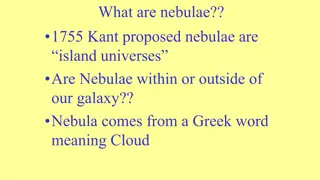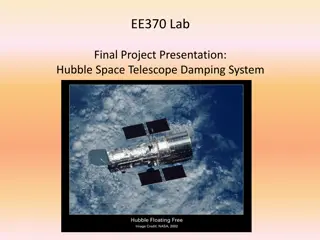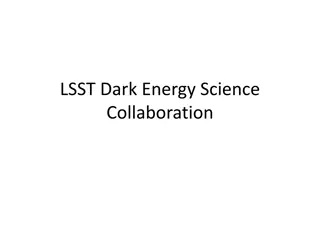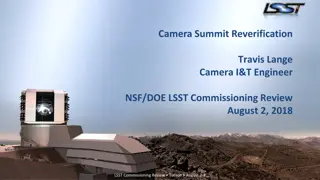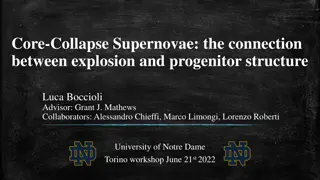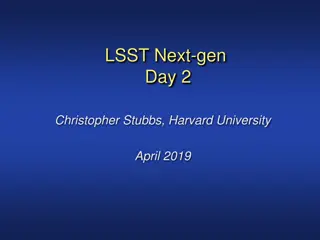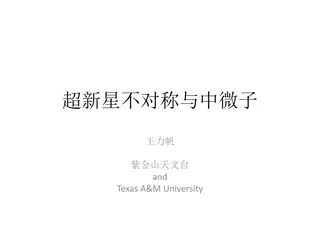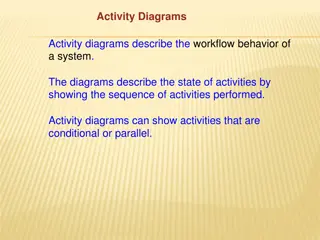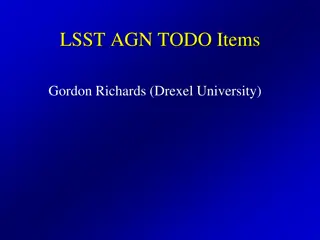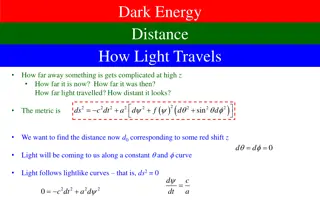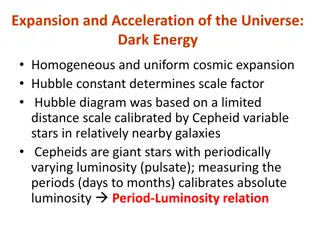Cadence for Supernovae in LSST and Dark Energy Hubble Diagrams
This content discusses the cadence for supernovae observations in the Large Synoptic Survey Telescope (LSST) and presents Hubble diagrams related to Supernovae and Dark Energy research. The images and descriptions focus on cosmological aspects, distance moduli, observational strategies, and constraints on dark energy derived from supernovae data.
Download Presentation

Please find below an Image/Link to download the presentation.
The content on the website is provided AS IS for your information and personal use only. It may not be sold, licensed, or shared on other websites without obtaining consent from the author.If you encounter any issues during the download, it is possible that the publisher has removed the file from their server.
You are allowed to download the files provided on this website for personal or commercial use, subject to the condition that they are used lawfully. All files are the property of their respective owners.
The content on the website is provided AS IS for your information and personal use only. It may not be sold, licensed, or shared on other websites without obtaining consent from the author.
E N D
Presentation Transcript
Cadence for supernovae in LSST Ph.Gris1, N.Regnault2 LSST@Europe3 LSST Science: Supernova/Transients/variable stars 1 Laboratoire de Physique de Clermont IN2P3/CNRS 2 Laboratoire de Physique des Hautes Energies IN2P3/CNRS 1
Supernovae and Dark Energy Hubble diagram M. Betoule et al. A&A, Vol. 568,id.A122 Distance modulus Redshift 2
Supernovae and Dark Energy Hubble diagram M. Betoule et al. A&A, Vol. 568,id.A122 Distance modulus Cosmology (fit) -> Dark Energy constraints ~ 740 Supernovae Redshift 3
Supernovae and Dark Energy Hubble diagram M. Betoule et al. A&A, Vol. 568,id.A122 Distance modulus Cosmology (fit) -> Dark Energy constraints ~ 740 Supernovae LSST : type Ia Supernovae for Hubble diagram large sample (x few 100) well calibrated (photometry) well measured with minimal bias (ie high redshift completeness) Redshift 4
Supernovae and Dark Energy Hubble diagram M. Betoule et al. A&A, Vol. 568,id.A122 Distance modulus Space Obs. (EUCLID , WFIRST) LSST compl. LSST WFD LSST DDF Redshift 5
Supernovae and Dark Energy Hubble diagram M. Betoule et al. A&A, Vol. 568,id.A122 Distance modulus Space Obs. (EUCLID , WFIRST) LSST compl. LSST WFD LSST DDF Redshift 6
Supernovae and Dark Energy Distance modulus 7
Supernovae and Dark Energy Distance modulus Supernova parameters B-band magnitude (max) Stretch (intrinsic) Color (extinction host - extrinsic) Estimated from light curves (SALT2 fit) 8
Supernovae and Dark Energy Estimated from (Hubble diagram) fit (with cosmological parameters) 0.14 3.1 Distance modulus error on distance modulus dominated by C high quality supernovae : C 0.04 ( 0.1) Extracted from light curves Observing strategy 9
Main parameters driving SN science Parameter Impact Typical value cadence +multiband observations Light curve quality (SN parameters estimation) median: 3 days-1 with limited variations season length Number of SN collected 170-180 days depth High z detection 5- depth ~ 26.5, 26.2, 25.6, 24.7 for r, i, z, y bands (DDF) The goal : collect a large and unbiased (z 0.8 DDF) sample of well measured ( C 0.04) type Ia supernovae. 10
Cadence for SN in LSST Observing strategy : current baseline minion_1016 Total number of visits : 2,448,282 (1 visit = 2 exposures of 15s) 3 types of surveys: - universal (WFD) ~ 90% -> Supernovae - mini-surveys : ~5% - Deep (DDF) : ~5% -> Supernovae Median cadence [day-1] Season 11
Cadence for SN in LSST DDF minion_1016 Cadence metric Number of Supernovae MC simulations Parameters : DayMax, X1, c, z LC curve fits SN rate production get a reliable estimation of the number of well-measured SN after ten years. cadence [day-1] N (SN Ia) 250 4 DDF ten years N(SN Ia) ~ 11000 year 12 5- depth
Cadence for SN in LSST improving the cadence - DDF New simulation : feature_baseline_10yrs : better cadence (regular 3 days-1) same depth + improved sky model+ season length increased Number of Supernovae Cadence metric minion_1016 cadence [day-1] N (SN Ia) 250 4 DDF ten years N(SN Ia) ~ 11000 5- depth year feature_baseline 450 cadence [day-1] N (SN Ia) 4 DDF ten years N(SN Ia) ~ 16400 (without bad year 2 18000) 13 5- depth year
Cadence for SN in LSST WFD Minion_1016 and alternative scenarios (rolling cadence) being studied. 14
Cadence for SN in LSST WFD Minion_1016 and alternative scenarios (rolling cadence) being studied. 15 Of interest for SN science measurements
Cadence for SN in LSST WFD Minion_1016 and alternative scenarios (rolling cadence) being studied. Rolling cadences 16 Altsched rolling vs feature : g: -21% r : +14% i: -32% z: + 16%
Cadence for SN in LSST WFD Average cadence altsched minion_1016 17
Cadence for SN in LSST WFD Average cadence Feature rolling 2/3 altsched_rolling 18
Cadence for SN in LSST WFD - Number of SNe alt_sched_rolling_min_cadence_025.mp4 feature_baseline_10yrs_min_cadence_025.mp4 altsched_rolling feature_baseline http://supernovae.in2p3.fr/~nrl/lsst_sn_cadence/FullSample/ 19
Cadence for SN in LSST Summary A large sample of well measured of type Ia supernovae is mandatory to set tight constraints on the nature of Dark Energy A suitable observing strategy is crucial to collect this sample: Cadence + multi-band observations Depth Season length Proposed strategies lead to the following conclusions (10 years): DDF : 4 fields - between 11000 to 18000 Sne Ia ; completeness z ~ 0.7 Altsched 250,000 Altsched rolling WFD N (SN Ia) feature rolling 2/3 150,000 feature rolling 1/2 50,000 minion feature baseline 20 MJD [days]
Cadence for SN in LSST Summary Possible improvements of cadence (wrt SN science): WFIRST CVZ DDF Increase the number (up to 8 ? ): Dark Energy anisotropies (w0,w1) Synergy with space obs. Increase zlimit? Increase season lengths ? Ultra Deep fields (2x DDF depth)? WFD Huge variations seen between simulators Rolling cadence strategy tend to lead to highest zlimitvalues Better cadence in g would help A call for white papers on LSST cadence optimization will be made soon. We will use the tools developed (and probably many more) up to now to estimate the best observing strategy from the SN science point of view. 21



![get⚡[PDF]❤ The Hubble Space Telescope: From Concept to Success (Springer Praxis](/thumb/21514/get-pdf-the-hubble-space-telescope-from-concept-to-success-springer-praxis.jpg)
